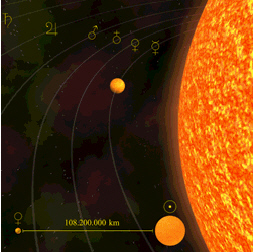|
|
|
MERCURY
Mercury / Introduction
Mercury is named after the Roman messenger of gods and god of traders. It is
the planet closest to the sun with a mean distance of only 57.9 million
kilometers. The diameter of Mercury is 4880 kilometers and it is the second
smallest planet in the Solar System. Only Pluto has smaller dimensions.
 The
orbit of Mercury is extremely eccentric and slightly inclined towards the
orbit planes ofthe other planets.Mercury revolves around the sun ina period
of 88 days. The
orbit of Mercury is extremely eccentric and slightly inclined towards the
orbit planes ofthe other planets.Mercury revolves around the sun ina period
of 88 days.
The American spacecraft Mariner 10 enabled scientists to study this planet
in detail. The spacecraft passed close to Mercury in 1974. The results
suggest that the surface of Mercury resembles that of the moon and that the
planet has an extremely thin atmosphere.
Orbit of Mercury
Mercury is the innermost planet of the Solar System. The distance of the
planet from the sun is between 46 million and 70 million kilometers.
 This indicates a highly eccentric orbit, which is inclined to the orbits of
most other planets.Only the orbit of Pluto has a more prominent inclination. This indicates a highly eccentric orbit, which is inclined to the orbits of
most other planets.Only the orbit of Pluto has a more prominent inclination.
Its rotation period is approximately 59 days.
One day on Mercury, i.e. the period between two sunrises, equals about 176
earth days.
Its orbit period around the sun is 88 days. Therefore, on Mercury, one day
equals two years.
Mercury Surface
In the 1920s, the astronomer Antoniadi drew the first pictures of the
surface of the planet Mercury. He gave names to several dark bright spots
and also observed what he described as clouds.
More accurate data was only available in 1974, when the spacecraft Mariner
10 flew close to the planet and took many photographs of its surface. It
appears that the surface of Mercury resembles the surface of our moon.
There are many impact craters on Mercury called rupes believed to date back
to the stage when, during the development of the planet about 3 billion year
ago, its core started to shrink.The thin atmosphere, which is cloudless
consists mainly of helium with traces of hydrogen sodium, oxygen, neon,
argon and potassium. The small mass and its consequent small gravitational
force cannot hold a larger atmosphere.
The mean density of the planet has been calculated as 5.43 g/cm3, which is
very similar to the density of the earth. Astronomers assume therefore that
Mercury has an iron-nickel core.
Visibility of Mercury
Due to its short distance from thesun, Mercury cannot be observed easily.
The planetis only visible shortly before sunrise and afterdusk.
In the northern hemisphere, the planet is best visible in the evening sky in
spring and in early morning in autumn. During these periods, Mercury is at
the largest possible angle from the sun as seen from the earth.
This maximum elongation is only 28 degrees.
Mercury is visible in phases, similar to Venus and the moon and we can
therefore speak about full Mercury and new Mercury. In every century,
Mercury’s orbit traverses the sun as seen from the earth. Such an occurrence
is visible through telescopes and the planet appears as a small black disk
in front of the large disk of the sun.
© by megasystems
|
|
|